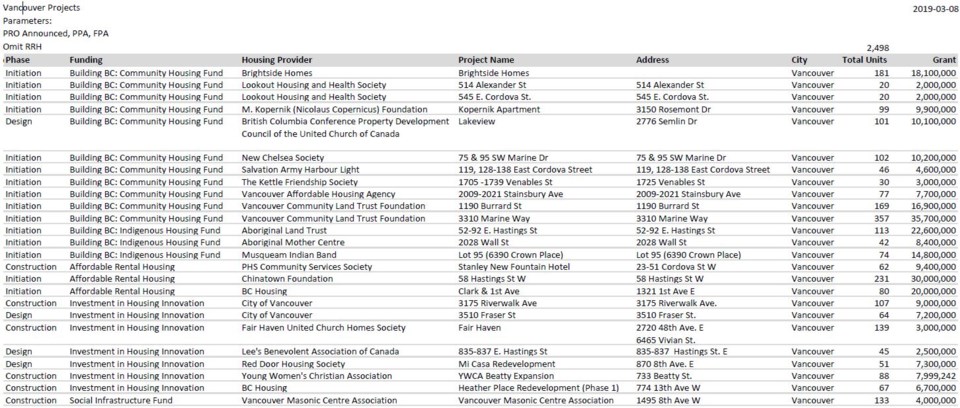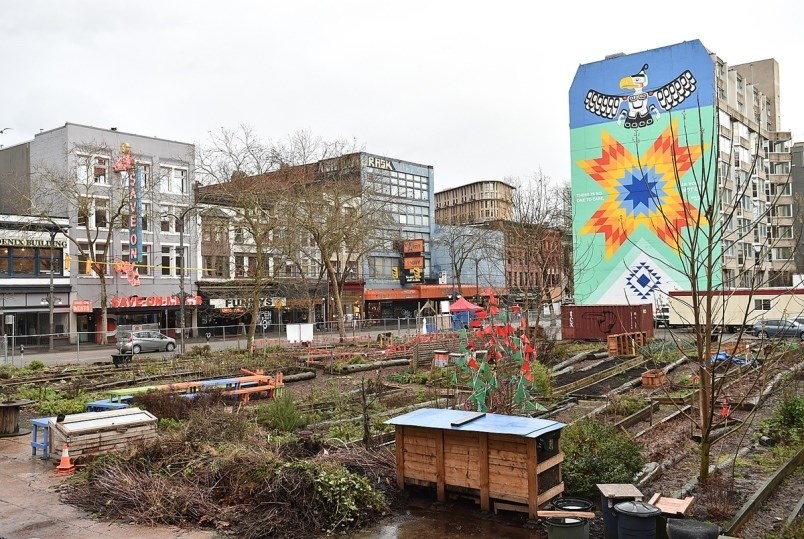Regular readers will know the provincial government announced March 4 that it has committed $3.1 million to keep 240 beds in eight Vancouver shelters open beyond their March 31 closing date.
In that same announcement, the government said this:
“In the last 18 months, in addition to the [606 units in the] modular buildings now open, work has started on more than 2,450 new affordable rental homes in Vancouver as part of the Province's investments in affordable housing, some of which include shelter-rate units.”
That statement didn’t come with any further details about type of housing, where it was located, how much it cost and how many would rent for the $375 shelter rate. So I got in touch with the ministry and I’m now happy to report I have some details.
But keep in mind this disclaimer in the email I received from the Ministry of Municipal Affairs and Housing:
“While the Province follows the general definition of affordability, which is that rent does not exceed 30 per cent of income, different projects come out of different funding streams and are designed to be affordable for people in a range of incomes.”
To get started, I’m going to post below a list of the 25 projects, location, number of units and how much money the province committed to the projects. So I’ll give you a moment or two to view the list and then I’ll get to some detail I received from the ministry. You'll notice the list says 2,498 units, not 2,450 as in the release. Not sure why.

OK, so as you will see the housing is spread across the city, and is in various stages in the development process. That includes a 74-unit project to the tune of $14.8 million at 6390 Crown Place that I wasn’t aware of. The Musqueam Indian Band is listed as the housing provider.
To be clear, the “grant” money given by the government doesn’t cover the full cost of every project.
An example is the 231-unit project at 58 West Hastings. The City of Vancouver owns the property, the Vancouver Chinatown Foundation will be the leaseholder and Vancouver Coastal Health will be the health care provider.
Last time I checked, the project was estimated to cost more than $90 million. The government’s commitment is $30 million.
Many will recall this is the same project that former mayor Gregor Robertson promised to have all units be rented at welfare and pension shelter rates. As of Monday, the government says the project will “consist of a total of 50 per cent shelter rate and 50 per cent HIL units.”
What does HIL mean?
Answer: Housing Income Limits, which represent the income required to pay the average market rent for what BC Housing says is “an appropriately sized unit in the private market.” Average rents are derived from Canada Mortgage and Housing Corporation’s annual rental market survey.
In Vancouver, for example, the required income is listed as $48,000 to pay for a one-bedroom. It’s $29,500 in Chilliwack and $36,000 on the Sunshine Coast.
So how much will people pay to live in these places on the list?
Let’s look at the Musqueam project and the Aboriginal Land Trust and Aboriginal Mother Centre projects. The government says the homes in those buildings are reserved for low to moderate-income households.
So, the government says, the rents will be geared to income, which means people will pay “approximately 30 per cent of their gross household income.”
Now to the projects under the “Building BC: Community Housing Fund,” which you will see at the top of the list. The government says the majority of units in these places will go to households with incomes below BC Housing’s HIL rate and pay “approximately 30 per cent of their household income.”
Here’s how the ministry explained it further to me in the email:
“This includes 20 per cent of units for low-income households making less than $30,000 [deeply subsidized rent-geared-to-income units] and 50 per cent for low-to-moderate income households with incomes below the Housing Income Limits.”
“The remaining 30 per cent of units are rented at market rates affordable for eligible moderate-income households, defined as household incomes up to $71,200 for homes with less than two bedrooms, or up to $104,000 for homes with two or more bedrooms.”
The re-do of the Stanley New Fountain Hotel, which was announced last spring, will offer the same breakdown of rental rates as the project at 58 West Hastings—a total of 50 per cent at the shelter rate and 50 per cent at HIL rates.
Specific rents have not been determined for the recently approved detox and social housing complex at Clark and East First Avenue. The government has committed $20 million for 80 units. The building will serve low-to-moderate income residents, including families, singles, people with disabilities and seniors.
The government says 50 per cent of all units will be for households with incomes at or below BC Housing’s HIL rate.
The remainder of the projects on the list are reserved for people living on low-to-moderate incomes, according to my information from the ministry.
I’m posting this information on the first day of the city’s annual homeless count.
Last March, volunteers counted 2,181 people without a home. Since then, the city has opened more than 500 units of temporary modular housing that was paid for by the B.C. government.
In fact, the total number of modular housing units built under the government’s program is 606, but 78 in Marpole were already open during last year’s count.
Anyway, when you add the 606 units to the 2,498 on the list above, Vancouver appears to be on track to put a dent in homelessness. But, as I recall, I used the same simple math when the previous government opened more than 1,500 units of housing at 13 supportive housing sites.
The result: Homelessness still went up.
Why?
Good question, and one I examined in this feature story I wrote last week.
@Howellings



